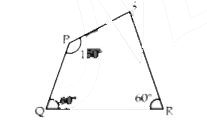PQR is a triangle, whose area is 180 cm2. S is a point on side QR, such that PS is the angle bisector of ∠QPR. If PQ: PR = 2: 3, then what is the area (in cm2) triangle PSR?
90
108
144
72
To solve the problem step by step, we will use the properties of triangles and the angle bisector theorem.
1. Understanding the Given Information:
- We have triangle PQR with an area of 180 cm².
- PS is the angle bisector of angle QPR.
- The ratio of sides PQ to PR is given as 2:3.
2. Using the Angle Bisector Theorem:
- According to the angle bisector theorem, the ratio of the lengths of the two segments created by the angle bisector on the opposite side is equal to the ratio of the other two sides.
- Therefore, we can set:
QSSR=PQPR=23
- Let QS = 2x and SR = 3x for some value x.
3. Finding the Total Length of QR:
- The total length of QR is:
QR=QS+SR=2x+3x=5x
4. Finding the Areas of Triangles PQS and PSR:
- The area of triangle PQR can be expressed in terms of the areas of triangles PQS and PSR:
Area of PQR=Area of PQS+Area of PSR
- The ratio of the areas of triangles PQS and PSR will be the same as the ratio of QS to SR:
Area of PQSArea of PSR=QSSR=23
5. Expressing Areas in Terms of a Variable:
- Let the area of triangle PSR be A. Then the area of triangle PQS can be expressed as:
Area of PQS=23A
- Therefore, the total area of triangle PQR can be expressed as:
23A+A=180
- This simplifies to:
53A=180
6. Solving for Area of Triangle PSR:
- To find A, multiply both sides by 35:
A=180×35=108 cm2
7. Conclusion:
- The area of triangle PSR is 108 cm2.
Final Answer:
The area of triangle PSR is 108 cm².
- We have triangle PQR with an area of 180 cm².
- PS is the angle bisector of angle QPR.
- The ratio of sides PQ to PR is given as 2:3.
- According to the angle bisector theorem, the ratio of the lengths of the two segments created by the angle bisector on the opposite side is equal to the ratio of the other two sides.
- Therefore, we can set:
QSSR=PQPR=23
- Let QS = 2x and SR = 3x for some value x.
- The total length of QR is:
QR=QS+SR=2x+3x=5x
- The area of triangle PQR can be expressed in terms of the areas of triangles PQS and PSR:
Area of PQR=Area of PQS+Area of PSR
- The ratio of the areas of triangles PQS and PSR will be the same as the ratio of QS to SR:
Area of PQSArea of PSR=QSSR=23
- Let the area of triangle PSR be A. Then the area of triangle PQS can be expressed as:
Area of PQS=23A
- Therefore, the total area of triangle PQR can be expressed as:
23A+A=180
- This simplifies to:
53A=180
- To find A, multiply both sides by 35:
A=180×35=108 cm2
- The area of triangle PSR is 108 cm2.
The area of triangle PSR is 108 cm².
Topper's Solved these Questions
Similar Questions
Knowledge Check
PQR is a triangle, whose are is 180cm2 . S is a point on side QR, such that PS is the angle bisector of ∠QPR . If PQ : PR = 2 : 3 , then what is the area (in cm2) triangle PSR ?
A90B108C144D72In a triangle PQR, PX bisects QR. PX is the angle bisector of angle P. If PQ=12 cm and QX=3 cm, then what is the area (in cm2) of triangle PQR?
A12√3B8√15C18√2D9√15PQR is a right angled triangle at Q in which PQ = QR. If the hypotenuse of the triangle is 20 cm, then what is the area (incm2) of the triangle PQR ?
A100√2B100C50√2D50
If Q is a point on the side SR of a triangle PSR such that PQ=PR then prove that PS>PQ
View SolutionPQRS is a rectangle, A, B, C and D are the mid points of sides PQ, QR, RS and PS respectively. If area of ΔPQR is 48 cm2, then what is the area (in cm2) of ΔBCD?
View SolutionPQRSis a rectangle. Points A, B, C and D are the mid points of sides PQ,QR,RSandPSrespectively. If area of ΔPQR is 48cm2, then what is the area (in cm) of ΔBCD?
View SolutionPQRSis a rectangle in which side of PQ=24cm. and QR=16cm. T is a point on RS. What is the area (in cm.) of the triangle PTQ?
View SolutionIn ΔPQR measure of angle Q is 90∘. If cosP = 5/13, and PQ = 2.5cm, then what is the length (in cm) of side PR?
View Solution

